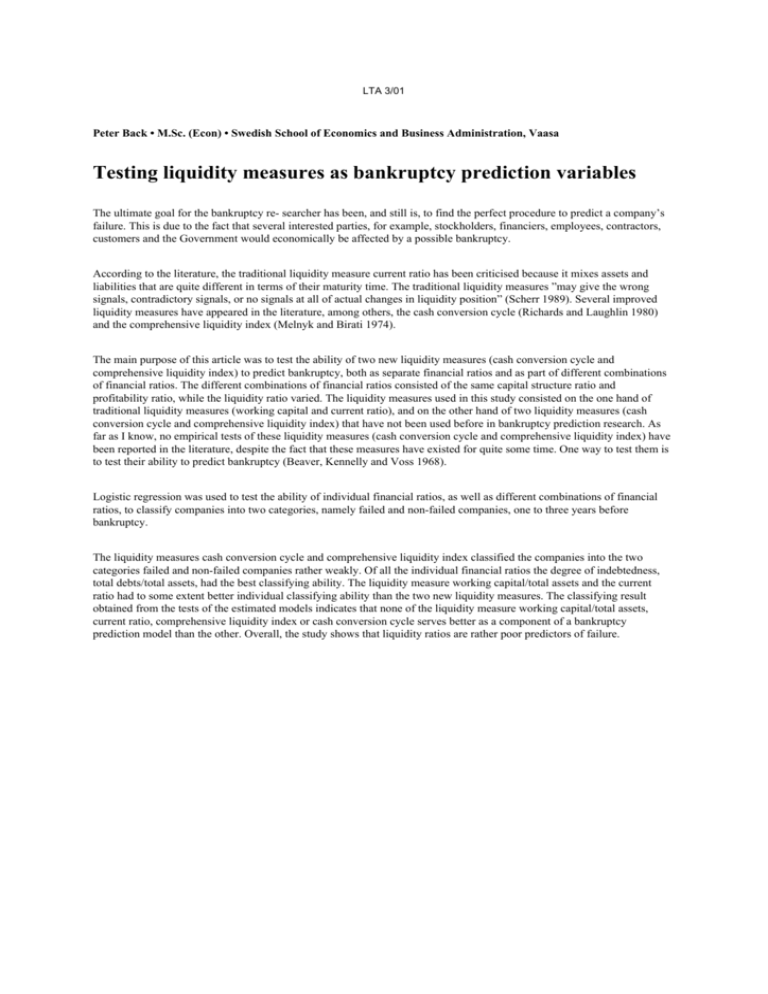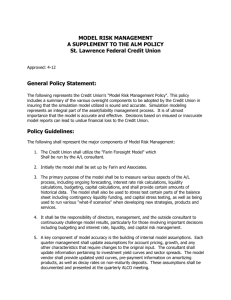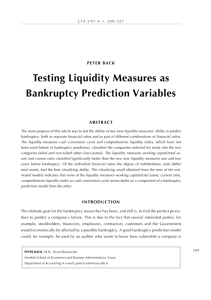Testing liquidity measures as bankruptcy prediction variables
advertisement

LTA 3/01 Peter Back • M.Sc. (Econ) • Swedish School of Economics and Business Administration, Vaasa Testing liquidity measures as bankruptcy prediction variables The ultimate goal for the bankruptcy re- searcher has been, and still is, to find the perfect procedure to predict a company’s failure. This is due to the fact that several interested parties, for example, stockholders, financiers, employees, contractors, customers and the Government would economically be affected by a possible bankruptcy. According to the literature, the traditional liquidity measure current ratio has been criticised because it mixes assets and liabilities that are quite different in terms of their maturity time. The traditional liquidity measures ”may give the wrong signals, contradictory signals, or no signals at all of actual changes in liquidity position” (Scherr 1989). Several improved liquidity measures have appeared in the literature, among others, the cash conversion cycle (Richards and Laughlin 1980) and the comprehensive liquidity index (Melnyk and Birati 1974). The main purpose of this article was to test the ability of two new liquidity measures (cash conversion cycle and comprehensive liquidity index) to predict bankruptcy, both as separate financial ratios and as part of different combinations of financial ratios. The different combinations of financial ratios consisted of the same capital structure ratio and profitability ratio, while the liquidity ratio varied. The liquidity measures used in this study consisted on the one hand of traditional liquidity measures (working capital and current ratio), and on the other hand of two liquidity measures (cash conversion cycle and comprehensive liquidity index) that have not been used before in bankruptcy prediction research. As far as I know, no empirical tests of these liquidity measures (cash conversion cycle and comprehensive liquidity index) have been reported in the literature, despite the fact that these measures have existed for quite some time. One way to test them is to test their ability to predict bankruptcy (Beaver, Kennelly and Voss 1968). Logistic regression was used to test the ability of individual financial ratios, as well as different combinations of financial ratios, to classify companies into two categories, namely failed and non-failed companies, one to three years before bankruptcy. The liquidity measures cash conversion cycle and comprehensive liquidity index classified the companies into the two categories failed and non-failed companies rather weakly. Of all the individual financial ratios the degree of indebtedness, total debts/total assets, had the best classifying ability. The liquidity measure working capital/total assets and the current ratio had to some extent better individual classifying ability than the two new liquidity measures. The classifying result obtained from the tests of the estimated models indicates that none of the liquidity measure working capital/total assets, current ratio, comprehensive liquidity index or cash conversion cycle serves better as a component of a bankruptcy prediction model than the other. Overall, the study shows that liquidity ratios are rather poor predictors of failure.










